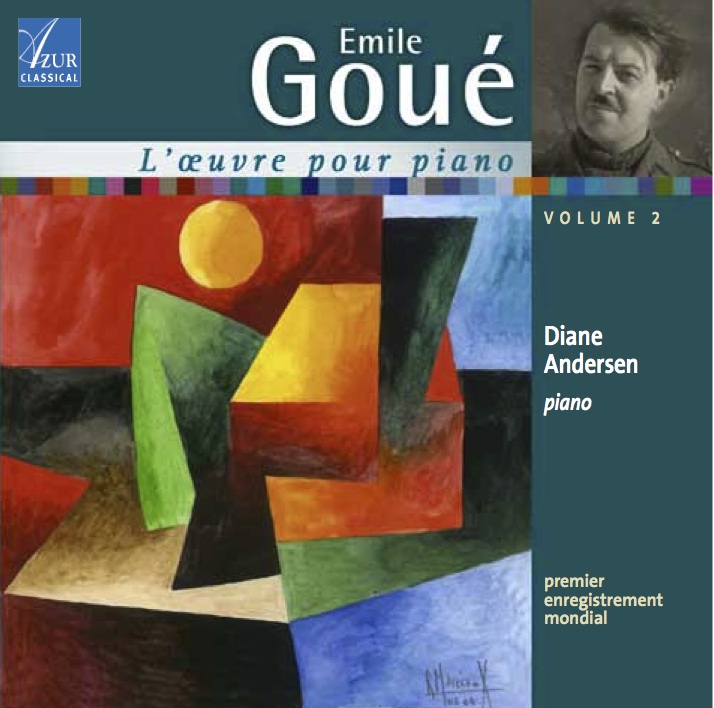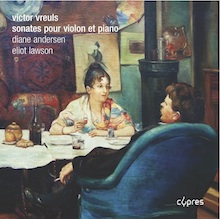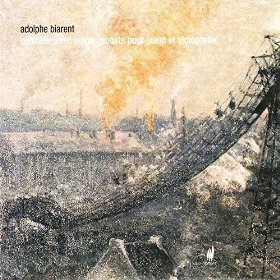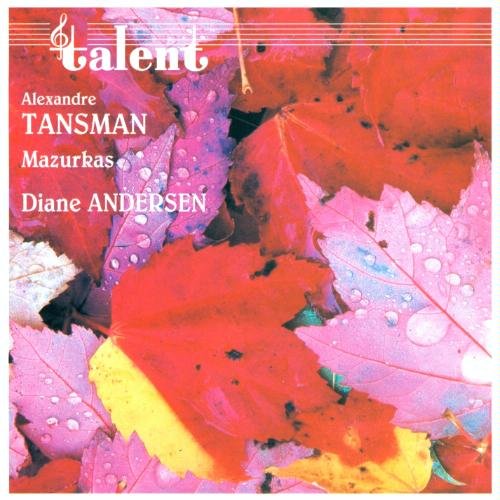Les œuvres de ce CD en hommage à Blanche Selva, qui nous a quitté il y a quatre-vingt ans, ont été composées spécialement pour cette grande virtuose et immense musicienne par ses amis compositeurs. Les faire revivre nous font revivre l’atmosphère de cette époque et met en lumière des partitions tombées, pour certaines, dans l’oubli.
The works of this CD in tribute to Blanche Selva, who left us eighty years ago, were composed specially for this great virtuoso artist and musician by her friend composers. Reviving them brings us back to the atmosphere of the musical life of that time and highlights scores that have fallen, for some, into oblivion.
Claude Delvincourt : L'œuvre pour piano, volume 1
Croquembouches - Cinq Pièces pour le piano - Œuvres de jeunesse inédites
The mouth-watering morsels are vividly painted, and have such titles as ‘Omelette au rhum’, ‘Linzer tart’, ‘Meringue à la crème’ and ‘Plum pudding’. Andersen's broad colouristic range truly adds allure to these enticing dishes. Each shows a wealth of fantasy and invention. (...) Diane Andersen’s stylishly idiomatic playing (...) makes a positive case for these deliciously melodic pieces. (...) I look forward with eagerness to the next volume.
Toutes les pièces de ce programme sont enregistrées pour la première fois, c’est dire… Et pourtant, elles ont de quoi séduire : technique, goût, esprit. Diane Andersen fait d’emblée flamber le piano pour une Omelette au rhum qui mériterait plusieurs étoiles au guide Debussy.
(Pierre Gervasoni, Le Monde, 30 juin 2017)
-
-
-
-
- ROSNER 5 Ko-ans for Orchestra. Unraveling Dances. The Parable of the Law - Burchett/Palmer/LPO - TOCCATA 0465
- DELVINCOURT Croquembouches. Prelude and Fugue. Menuet. Gavotte. Valse.Galéjade. 5 Pieces for Piano - Andersen - AZUR 152
- BARTÓK For Children (revised version, 1943) - Bach - HÄNSSLER 17009
- W. S. BENNETT Piano Sonata No. 1, op. 13.
- SCHUMANN Symphonic Etudes, op. 13 - Takenouchi - ARTALINNA 018
- MOZART Sonatas for Piano, Four Hands: in D, K 381; in BΙ, K 358; in G, K 357; in F, K 497. Two-Piano Sonata in D, K 448 - Bakhchiev/Sorokina - MELODIYA 10 02252
If each of the recordings on this list were to win a specific prize, the trophy for Most Charming would without question go to Diane Andersen’s recital of piano works by Claude Delvincourt. Who could fail to be tickled by a large-scale piano suite, ten movements of which attempt to evoke different desserts (and which chastens the gluttonous listener with doses of prairie oysters and castor oil in the final movements)? Or by a minute-long antic tall tale that somehow manages to bluff the listener into perceiving it as much more extensive? Listen to Delivincourt’s Croquembouches and Galéjade and see if you can resist. The 5 Pieces for Piano, while not adhering to any specific program, offer an equally tart delectation.
(Myron Silberstein - Want List, in Fanfare, August 2018)
Paul Paray: Œuvres pour cordes et piano
Eliot Lawson (violon), Samuel Magill (violoncelle), Diane Andersen (piano)
Sonate pour violon et piano - Sonate pour violoncelle et piano Sérénade - Humoresque – Nocturne – Romance
Paul Paray (1886-1979) affirma très tôt son goût pour la composition, à la Maîtrise de la Cathédrale de Rouen puis au Conservatoire de Paris, où il fut l'élève de Xavier Leroux et Georges Caussade. Il obtint le Grand Prix de Rome en 1911. Sa carrière de chef d'orchestre se développa brillamment à partir de 1920, au point d'occulter partiellement ses travaux de compositeur. Son invention mélodique et son raffinement harmonique prolongent la tradition de l'école française.
Paul Paray (1886-1979) very early confirmed his taste for composition, first with the choirs of the Cathedral of Rouen, then at the Paris Conservatory of Music, where he was the pupil of Xavier Leroux and Georges Caussade. He obtained the Grand Prix de Rome in 1911. His career as a orchestra conductor progressed brilliantly after 1920, to the point that it partly eclipsed his work as a composer. The inventive quality of his melodies and the refinement of his harmonies are well aligned with the French school tradition.
All the works are lovingly performed and well-projected. Sound quality, as with all the Azur Classical recordings I’ve heard from Studio Recital B (Tihange-Belgium), is intimate, yet allows space and air around the instruments, with an ideal balance struck.
Ces partitions aussi rares qu'intéressantes sont bien défendues par le violoniste belge-brésilien Eliot Lawson, à la sonorité solaire et au dynamisme débordant, le violoniste américain Samuel Magill, intense et servi par un timbre émouvant et Diane Andersen, la grande dame du piano belge, au répertoire si riche et varié. Une belle découverte.
(Jacques Bonnaure, Classica n°195, 31 août 2017)

The result is an experience that is almost more of listening to different compositions than of different interpretations of the same compositions. With Tanau and Perrone, the emphasis in the opening Allegro moderato of the Violin Sonata is emphatically Allegro, a rushing whirlwind of energy, whereas with Lawson and Andersen it is definitely moderato, ruminative and reflective, while in the Humoresque hats are reversed and it is Lawson and Andersen who give a blistering rendition while Tanau and Perrone are more relaxed. Likewise, with Deleury and Perrone the central Andante of the Cello Sonata is lyrically songful, whereas with Magill and Andersen it is charged with deep pathos. In all cases the respective interpretations fully justify themselves, and I would be hard-pressed to choose one over the other. (...)
Against that, Azur has significantly better recorded sound, and overall superior players. Not that Tanau, Deleury, or Perrone have anything to be ashamed of; they are quite good. But while Tanau is almost on a par with Lawson on the violin, when it comes to the cello the difference between Deleury and Magill is that between a skilled professional and a world-class artist (Magill’s opulent tone is positively seductive), and Andersen likewise outclasses Perrone at the piano. (...)
Enthustiatically recommended.
(James A. Altena, Fanfare)
Claude Delvincourt : L'œuvre pour violon et piano, volume 1
Eliot Lawson et Diane Andersen
Danceries - Sonate pour violon et piano
Contemplation - Sonate de jeunesse inédite
Ce premier volume de la musique de chambre de Delvincourt recèle un autre trésor, une Sonate inédite de 1907 (...). Trois de ces œuvres ont déjà été enregistrées, assez récemment (...) mais ici, outre l'interprétation très engagée d'Eliot Lawson et de Diane Andersen, une très grande pianiste trop méconnue en France, la présence de la Sonate inédite est un avantage déterminant.
(Jacques Bonaire, Classica, mars 2015)
Eliot Lawson und die Pianistin, Diane Andersen, spielen in wachem Dialog, mit genau dem Raffinement, der Rhythmik und dem Sensualismus, den diese Musik vom Interpreten erfordert. Bei solcher Qualität wartet man gerne auf mehr.
(Remy Franck, Pizzicato, février 2015)
On doit d'autant plus saluer les promoteurs de cette initiative de redécouverte qu'elle ne pouvait pas s'appuyer sur grand-chose, sinon la qualité du compositeur, qui s'avère être son meilleur ambassadeur, grâce aussi à des interprètes de grande qualité.
(Danielle Anex-Cabanis, Utmisol, février 2015)
L’art et la maturité de Diane Andersen n’est sans doute pas pour rien dans cette réussite du deuxième volume...
On ne peut que louer Diane Andersen de s’être si bien approprié la personnalité du compositeur, et d’en livrer un portrait sincère, presque familier, comme si elle l’avait fréquenté en personne.
(Bruno Peeters, Crescendo, mars 2012)
La pianiste Diane Andersen dotée d’un curriculum vitae plus conséquent que sa notoriété médiatique s’avère être une artiste de haut niveau, sensible, précise, équitable, au service intègre de la musique d’Emile Goué.
Premier enregistrement mondial des pièces pour piano - toutes de délicatesse et subtilité (…) Merci à la grande pianiste belge Diane Andersen de s’être penchée sur cette oeuvre - à découvrir absolument !
Le duo piano-violon confronte deux générations d’artistes belges: l’expérimentée pianiste Diane Andersen, pour qui les musiques belges de cette époque n’ont plus de secrets, et le jeune Eliot Lawson, un chambriste brillant. L’entente entre les deux musiciens est parfaite et est au service de ces belles partitions.
(Jean-Pierre Tribot, ResMusica)
Adolphe Biarent: Contes d'Orientavec l'Orchestre Philharmonique de Liège sous la direction de Pierre Bartholomée
Disponible sur
Amazon et
iTunes Store.
Adolphe Biarent - Quintette à clavier et Sonate pour violoncelle et piano
avec le Quatuor Danel et Mark Drobinsky
"stunning"... "breathtaking"! The Piano Quintet certainly ranks with those of Dvorak, Brahms, Franck and Fauré, while the Cello Sonata (Mark Drobinsky , cello) strikes me as the finest since Beethoven, not forgetting Brahms. They are that good. So are the performances. Diane Andersen and the Danel Quartet... This is a true chamber music event... please don't miss this release.
A phenomenal disc of chamber music by Adolphe Biarent." "Thrilling"... "dazzling"... "brilliant"...
(David Hurwitz, "ClassicsToday.com")
Diane Andersen is a superb pianist. This performance of the (Biarent) piano quintet is marvellous throughout. Andersen is by turns rapturous and brilliant, with silvery runs and lyrical expression that perfectly matches the composition.
("Fanfare" USA)
The excellent Belgian composer, Adolphe Biarent deserves to be known the world over. Andersen's splendid performance of his Quintet is truly irresistible.
(M.G. "EPTA-Italy News")

La Sonate est un hommage à Franck et l'héritière des deux grands triptyques du Pater Seraphicus. De telles épopées réclament des pianistes hors pair: cela explique la rareté des interprètes modernes. La difficulté technique est extrême, et tient non pas tant à la virtuosité qu'à la nécessité de clarifier un rébus harmonique ultra-chromatique et de faire chanter des hymnes ourlés par la trame complexe d'une dense polyphonie. Diane Andersen s'y entend à merveille. On connaissait déjà sa vaste palette sonore par une belle intégrale Jongen chez Pavane. Elle affirme ici à la fois une remarquable maîtrise des multiples plans sonores et un sens dramatique grâce auquel le triomphe final s'impose comme inévitable terme de l' ascension... Grâce à elle, un pas décisif est franchi vers la réhabilitation de l'auteur du "Jour d'été".
(Michel Fleury, Classica - récompense R10Classica)
Listening to this masterful performance by Diane Andersen, it's hard to understand why this might be so. Written on a vast scale and aspiring to the greatness of Beethoven's later sonatas, d'Indy's three-movement sonata is a work in the heroic grand manner and its technical fluency and expressive intensity mark it as part of d'Indy's oeuvre. Played here with total commitment and tremendous brio by pianist Andersen, the sonata comes alive in a masterful performance. Andersen doesn't undersell the work's lyricism, nor does she oversell its climaxes, but rather, she grants the work its due in a reading that speaks both to the head and the heart. Andersen's account of d'Indy's sonata should be heard by all fans of French late romantic composers.
(James Leonard, All Music Guide)
Better than an interpreter enclosed in a repertoire of the past, Diane Andersen has the capacity of observing from "the balcony" a piece like this Sonata by d'Indy and taking the dimension of it. Andersen plays all this very naturally, things seem evident, and God knows which kind of lucidity and musical experience this work require for being dominated.
(R.G., "Echo de la Bourse", Brussels)
Diane Andersen plays this sonata not only with a great instrumental mastery but brings to life what is "behind the notes", which is at the very end the only justification of an interpretation.
(C. de Nys, "La Libre Belgique")
Joseph Jongen: Trio op.10, Aquarelles op. 59, deux pièces en trio op. 95avec l'Ensemble Joseph Jongen.
Disponible sur
Amazon et
iTunes Store.
We find here again with great pleasure the pianist Diane Andersen, this "Grand Lady of the Belgian Piano" and her colleagues of the ensemble of same name as the composer, the Ensemble Joseph Jongen. The Ensemble did already record magnificently for Cypres label the piano Quartet op. 23 and the Trio for viola, cello and piano op. 30 and it was very natural, that the same interpreters delivered to us an exhaustive version of the other trios by the great composer.
(M. Tibbault, "ResMusica.com")
Admirable, and finally a piano played with all the needed orchestral timbres! Diane Andersen masters the rythmical complexity of the piano part and can guide the harmonic paths of the partners... The dream, with open eyes!
(J-Ch. Hoffelé Diapason Jan. 2007)
So etwas wie eine eigenständige belgische Musik gibt es kaum. Praktisch alle wichtigen Komponisten des Landes, von César Franck bis Henri Vieuxtemps, blickten stilistisch nach Paris. So auch der bei uns arg unterschätzte Joseph Jongen aus Liège/Lüttich. Das um die namhafte belgische Pianistin Diane Andersen gescharte "Ensemble Joseph Jongen" hält drei kammermusikalische Kostbarkeiten bereit – Zeugnisse von beeindruckender Ausdruckskraft. Aufgezeigt wird nicht zuletzt die Entwicklung eines wachen Komponisten, der sich des Zeitstrangs durchaus bewusst blieb. Im frühen h-Moll-Trio op. 10 (1897) wandelt er auf den Spuren von Fauré, während dreissig Jahre später die Deux Pièces op. 95 des angesehenen Direktors am Brüsseler Conservatoire von Debussy und Ravel beeinflusst sind.
(Der Bund; 11.01.2008; Seite bu31)
La Clef, Res Musica - CD of the Month, Classical CD Review
Joseph Jongen: L'Intégrale pour piano, vol. 1avec l'Ensemble Joseph Jongen.
Disponible sur
Amazon et
iTunes Store.
La Clef, Res Musica - CD of the Month, Classical CD Review
Joseph Jongen: L'Intégrale pour piano, vol. 2avec l'Ensemble Joseph Jongen.
Disponible sur
Amazon et
iTunes Store.
No presentation of this admirable pianist is any more needed. Andersen has a perfect and exceptionally flexible technique, an astonishing diversified touch, an always natural phrasing with a wonderful richness of nuances… shortly said : a marvellous musical sense served by exceptional fingers. An exhaustive interpretation by Diane Andersen !
(M. Tibbaut, RTBF Belgium)
Diane Andersen possesses impressive technical gifts but, more importantly, she possesses the intelligent sensitivity to imbue these wonderful pieces with devoted seriousness they deserve. One of the virtues of this two-CD set is her brilliant playing. Andersen’s control is formidable. Her tone is mellow but powerful, and her ability to shape phrases is impeccable.. The sound is remarkable : full, rich and powerful.
(Patrick Meanor-Fanfare Magazine Issue 27)
Diane Andersen plays beautifully throughout... This second volume is a pure joy from the first to the last, and a 'must' for all admirers of Jongen's music.
(H. Culot, "Musicweb-International")
Alexandre Tansman: Mazurkas
These 4 books of Mazurkas are a gem in Tansman’s œuvre. All his love for his home country, Poland, shines through every written note. Each kind of Mazurka is described so beautifully and brings to life the hidden lyricism in the music of this wonderful composer too little played in the concert halls.
Alexandre Tansman: Oeuvre pour deux pianos
avec Daniel Blumenthal.
Very exciting music for two pianos by a composer who also wrote music for the movie when he was staying in Hollywood during second world war. The Sonata is one of the composer’s most important pieces and the Fantasy one of his most brilliant !
Ernest Toch: Concerto for piano and Orchestra, Quintet for piano and string quartetDiane Andersen, Danel Quartet, Philharmonisches Staatsorchester Halle, dir. Hans Rothman
Disponible sur
Amazon.
Once again Diane Andersen has brought us some fine and fascinating lesser-known works. Andersen, consummate artist that she is, plays this repertoire convincingly. Listeners will not be disappointed.
(N.L.H. Piano Jounal n°81 2006)
Please do not be scared off by the initial paragraph, dear reader; this is a wonderful disc.(...)
His two concertos bear a relationship similar to Brahms's pair: the First more superficially virtuosic but the Second even more difficult to realize successfully. Put bluntly, there are at least as many notes in the Piano Symphony as in the Concerto, but they are not as loud.
Toch's op. 38 makes a stunning first impression, but over repeated hearings, op. 61 proves the more interesting work. Its opening Allegro presents a Bach-like theme that seems destined for contrapuntal treatment, but the piano's entrance turns it into pure Shostakovich—as usual, Toch was preceding his “influences.“ Another Toch characteristic is that his music sounds classically formal, yet one listens in vain for any hint of conventional structures; he seemed to emit music so naturally that no one has ever penetrated whatever tricks or secrets he used to hold it together. All four movements, Allegro, Lebhaft, Adagio, and Cyclus Variablis—Allegro molto, radiate good humor. The curiously named finale goes off in all directions, including a few passages of high-voltage virtuosity, yet it never loses coherence. This is a delightful piece.(...)
Diane Andersen performs a wide variety of standard and offbeat repertoire; she has been especially celebrated for her recordings of Bartók, both solo and with violinist André Gertler.
She is a marvel here, playing as if she had lived with both Toch works for decades, relishing every turn and finding complete satisfaction in every corner. The Quintet is more successful here than in two earlier recordings by the composer or one by Andre Previn, whose American Art Quartet emphasized the anguished elements in the piece; the Danel Quartet—an excellent ensemble which has also recorded the complete Shostakovich quartets—is very much in synch with Andersen in realizing its multi-hued qualities.
(James H. North, Fanfare)
Bartók: 14 Bagatelles, 4 Dirges, Improvisations, SonateDisponible sur
Amazon.
C'est vraiment l'interprétation de Bartók qui correspond par l'esprit et la technique à celle de Bartók. (...) En tout cas, je trouve le vôtre le meilleur que je connaisse et que je recommanderai à tout le monde comme le plus fidèle à Bartók. (...) Croyez à mon enthousiasme et à mes sincères félicitations.
It is really the interpretation of Bartók that best matches Bartók's spirit and technique. (...) Anyway, I find yours the best that I know and I will recommend it to everyone as the most faithful to Bartók. (...) Trust my enthusiasm and my sincere congratulations.
(Denijs DILLE, ami personnel de Bartok, fondateur du BARTOK ARCHIVUM, Budapest)
Voir la lettre de Denijs Dille





















